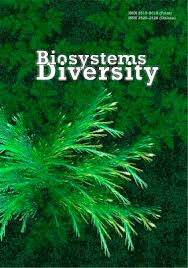Local taxonomic spectra in plants, animals, fungi and terrestrial protists show common mathematical patterns
Local taxonomic spectra in plants, animals, fungi and terrestrial protists show common mathematical patterns
Author(s): D. V. Leontyev, I. I. Yatsiuk, T. Y. Markina, L. P. Kharchenko, Е. V. Tverdokhleb, I. O. Fedyay, Y. A. YatsiukSubject(s): Agriculture, Environmental Geography
Published by: Дніпропетровський національний університет імені Олеся Гончара
Keywords: Agaricomycetes; Aves; biota; biodiversity; Bryophyta; Coleoptera; distribution fitting; Eumycetozoa; fauna; flora; Insecta; Magnoliophyta; Myxogastrea; Myxomycetes; national park; nature conservation
Summary/Abstract: Taxonomic spectra, i.e. relations between supraspecific taxa by the number of included species, remain poorly understood in aspect of the mathematical properties. We studied taxonomic spectra of plants (Magnoliophyta, Bryophyta), animals (Coleoptera, Aves), fungi (Agaricomycetes) and terrestrial protists (Myxomycetes), found in the Homilsha Forests National Nature Park (North-East of Ukraine), and concluded that they correspond to the hollow-curve distribution at the level of genera, families and orders. The spectra of most taxa, as shown by the Akaike information criterion, are closely approximated by the log-series distribution model at all taxonomic levels. This type of distribution is typical for the species abundance curves, based on collections made from small areas. At the same time, in the genera–families–orders row the similarity to the lognormal distribution increases. The central values and variability vary considerably between different taxonomic groups and ranks, however, without affecting the type of distribution. The number of orders in all taxa except Bryophyta has reached the saturation and coincides with the curve of the estimated number of orders according to the Chao1 coefficient. For families and especially genera the correspondence with estimated number of species is much lower. Our results do not confirm the assumption that hollow-curve distributions of taxonomic spectra result from the artificial fragmentation of taxa. These distributions neither depend on the insufficient knowledge about the species composition at the locality, nor reflect the size of the studied area. The presence of such distributions in both local and global biota of different groups may be explained by the common features of their evolution, especially by the existence of relict orphan groups. The fact that in Homilsha Forests the kurtosis and skewness of distributions decreases in the genera-families-orders row can therefore be explained by the relatively low percentage of the high-rank orphan taxa in the local biota. This may be a common feature of communities studied at small geographical scale, since orphan taxa often demonstrate a high level of endemism. Comparative studies of local communities from different climate zones may help to understand how universal are the patterns, described herein.
Journal: Biosystems Diversity
- Issue Year: 29/2021
- Issue No: 3
- Page Range: 269-275
- Page Count: 7
- Language: English

